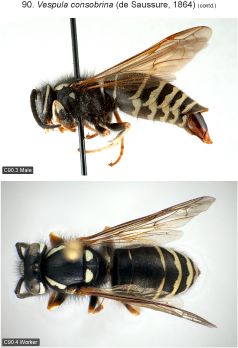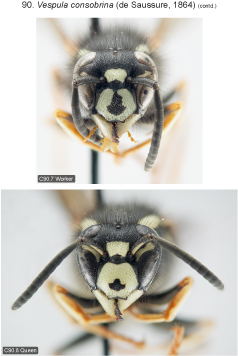
| Home | Table of contents | Keys | Species list | Glossary | Image data | PDF | Cite this article | Feedback | Updates |
Identification Atlas of the Vespidae (Hymenoptera, Aculeata) of the northeastern Nearctic region
CJAI 05, February 19, 2008
doi: 10.3752/cjai.2008.05
Matthias Buck, Stephen A. Marshall, and David K.B. Cheung
Department of Environmental Biology, University of Guelph, Guelph, Ontario, Canada N1G 2W1
Next species | Previous species | Key
90. Vespula consobrina (de Saussure, 1864) – Blackjacket
Figs B13.35, 58, 69; C90.1–10.
 |
 |
 |
 |
 |
Species recognition. The blackjacket is easily recognised by the ivory colour of its pale markings (shared with V. rufa) and the absence of ferruginous markings on terga 1 and 2 (present in V. rufa). Queens of V. consobrina are sometimes confused with the baldfaced hornet (Dolichovespula maculata) or with D. adulterina but both of the latter species have the fasciae of terga 4 and 5 interrupted or deeply incised medially (straight in V. consobrina).
Variation. Fore wing length 9.5–11.0 mm (workers), 13.0–14.0 mm (♀♀), ca. 10.5–12.5 mm (♂♂, n = 9). Black clypeal mark of female usually either free or extending to dorsal margin of clypeus, rarely extending to ventral margin, or both dorsal and ventral margins, or divided into three small spots; in male clypeal mark usually extending to ventral margin, sometimes also to dorsal margin, rarely free (in some cases reduced to three or one small spot(s)). Ivory stripe along inner orbit ending near apex of ocular sinus, in male often extending far along upper margin of sinus. Female with lower gena black, usually enclosing a small to medium-sized ivory spot ventrally; male with a ivory postocular band that is rarely interrupted near middle. Scape sometimes (often in male) with pale anterior mark. Apical fascia of tergum 1 in queen often, in worker and male occasionally, evanescent or absent. Xanthic queens sometimes with free black discal spots on terga 4 and 5 and narrowly connected spots on tergum 2.
Distribution. Canada: all provinces and territories except NU. Northern U.S. south to GA, KY, IL, WI, ND, CO, UT and CA (Carpenter and Kojima 1997).
Biology. Usually nests in abandoned rodent borrows in the ground but also in rotten logs, rock cavities or hollow walls. Live arthropods serve as prey. This species inhabits mainly forested areas and therefore infrequently comes into contact with man (Akre et al. 1981).
Next species | Previous species | Key
| Home | Table of contents | Keys | Species list | Glossary | Image data | PDF | Cite this article | Feedback | Updates |
